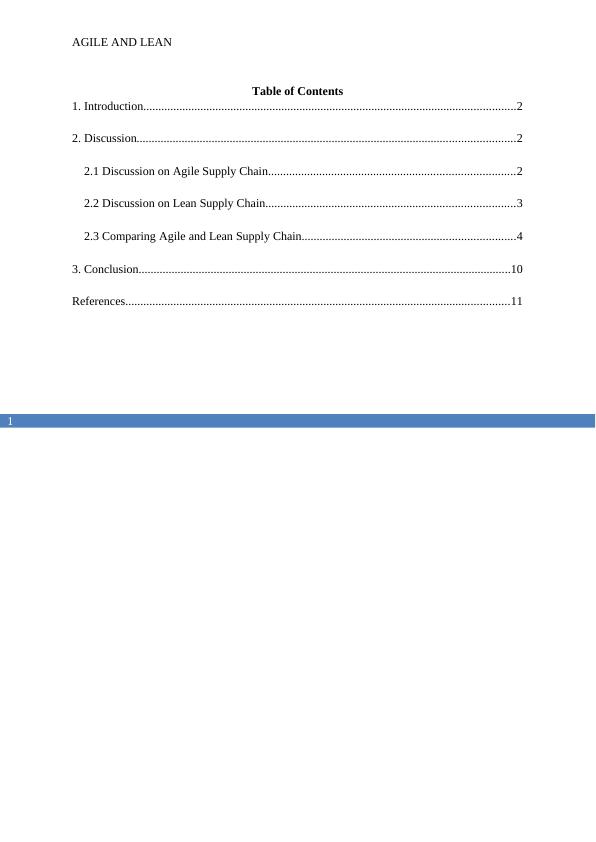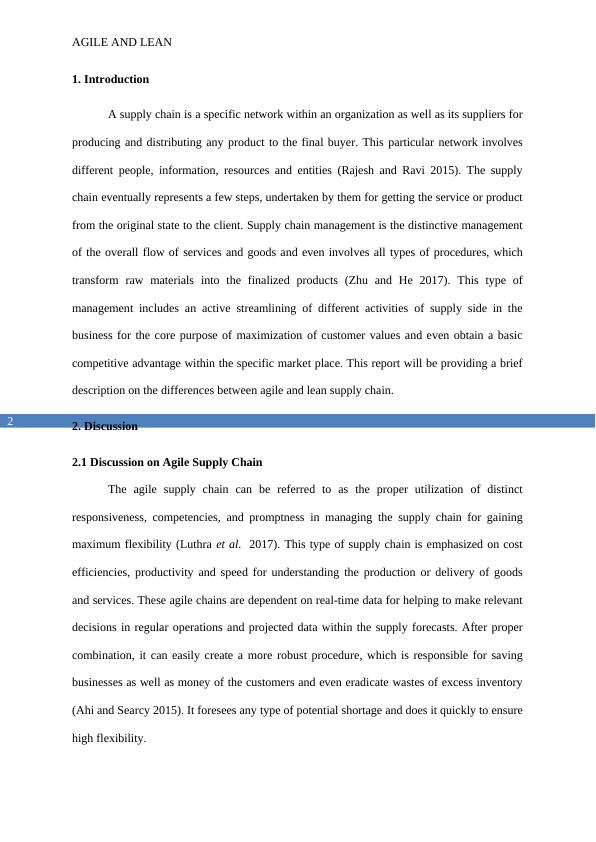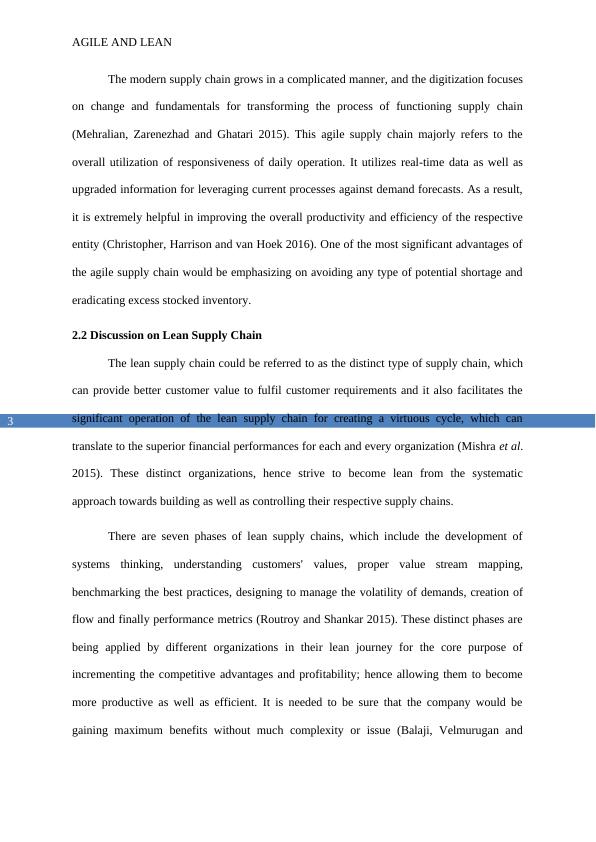Discussion on Agile and Lean Supply Chains
Added on 2022-08-12
15 Pages4163 Words489 Views
Running head: AGILE AND LEAN
Agile and Lean
Name of the Student
Name of the University
Author’s Note:
Agile and Lean
Name of the Student
Name of the University
Author’s Note:

1
AGILE AND LEAN
Table of Contents
1. Introduction............................................................................................................................2
2. Discussion..............................................................................................................................2
2.1 Discussion on Agile Supply Chain..................................................................................2
2.2 Discussion on Lean Supply Chain...................................................................................3
2.3 Comparing Agile and Lean Supply Chain.......................................................................4
3. Conclusion............................................................................................................................10
References................................................................................................................................11
AGILE AND LEAN
Table of Contents
1. Introduction............................................................................................................................2
2. Discussion..............................................................................................................................2
2.1 Discussion on Agile Supply Chain..................................................................................2
2.2 Discussion on Lean Supply Chain...................................................................................3
2.3 Comparing Agile and Lean Supply Chain.......................................................................4
3. Conclusion............................................................................................................................10
References................................................................................................................................11

2
AGILE AND LEAN
1. Introduction
A supply chain is a specific network within an organization as well as its suppliers for
producing and distributing any product to the final buyer. This particular network involves
different people, information, resources and entities (Rajesh and Ravi 2015). The supply
chain eventually represents a few steps, undertaken by them for getting the service or product
from the original state to the client. Supply chain management is the distinctive management
of the overall flow of services and goods and even involves all types of procedures, which
transform raw materials into the finalized products (Zhu and He 2017). This type of
management includes an active streamlining of different activities of supply side in the
business for the core purpose of maximization of customer values and even obtain a basic
competitive advantage within the specific market place. This report will be providing a brief
description on the differences between agile and lean supply chain.
2. Discussion
2.1 Discussion on Agile Supply Chain
The agile supply chain can be referred to as the proper utilization of distinct
responsiveness, competencies, and promptness in managing the supply chain for gaining
maximum flexibility (Luthra et al. 2017). This type of supply chain is emphasized on cost
efficiencies, productivity and speed for understanding the production or delivery of goods
and services. These agile chains are dependent on real-time data for helping to make relevant
decisions in regular operations and projected data within the supply forecasts. After proper
combination, it can easily create a more robust procedure, which is responsible for saving
businesses as well as money of the customers and even eradicate wastes of excess inventory
(Ahi and Searcy 2015). It foresees any type of potential shortage and does it quickly to ensure
high flexibility.
AGILE AND LEAN
1. Introduction
A supply chain is a specific network within an organization as well as its suppliers for
producing and distributing any product to the final buyer. This particular network involves
different people, information, resources and entities (Rajesh and Ravi 2015). The supply
chain eventually represents a few steps, undertaken by them for getting the service or product
from the original state to the client. Supply chain management is the distinctive management
of the overall flow of services and goods and even involves all types of procedures, which
transform raw materials into the finalized products (Zhu and He 2017). This type of
management includes an active streamlining of different activities of supply side in the
business for the core purpose of maximization of customer values and even obtain a basic
competitive advantage within the specific market place. This report will be providing a brief
description on the differences between agile and lean supply chain.
2. Discussion
2.1 Discussion on Agile Supply Chain
The agile supply chain can be referred to as the proper utilization of distinct
responsiveness, competencies, and promptness in managing the supply chain for gaining
maximum flexibility (Luthra et al. 2017). This type of supply chain is emphasized on cost
efficiencies, productivity and speed for understanding the production or delivery of goods
and services. These agile chains are dependent on real-time data for helping to make relevant
decisions in regular operations and projected data within the supply forecasts. After proper
combination, it can easily create a more robust procedure, which is responsible for saving
businesses as well as money of the customers and even eradicate wastes of excess inventory
(Ahi and Searcy 2015). It foresees any type of potential shortage and does it quickly to ensure
high flexibility.

3
AGILE AND LEAN
The modern supply chain grows in a complicated manner, and the digitization focuses
on change and fundamentals for transforming the process of functioning supply chain
(Mehralian, Zarenezhad and Ghatari 2015). This agile supply chain majorly refers to the
overall utilization of responsiveness of daily operation. It utilizes real-time data as well as
upgraded information for leveraging current processes against demand forecasts. As a result,
it is extremely helpful in improving the overall productivity and efficiency of the respective
entity (Christopher, Harrison and van Hoek 2016). One of the most significant advantages of
the agile supply chain would be emphasizing on avoiding any type of potential shortage and
eradicating excess stocked inventory.
2.2 Discussion on Lean Supply Chain
The lean supply chain could be referred to as the distinct type of supply chain, which
can provide better customer value to fulfil customer requirements and it also facilitates the
significant operation of the lean supply chain for creating a virtuous cycle, which can
translate to the superior financial performances for each and every organization (Mishra et al.
2015). These distinct organizations, hence strive to become lean from the systematic
approach towards building as well as controlling their respective supply chains.
There are seven phases of lean supply chains, which include the development of
systems thinking, understanding customers' values, proper value stream mapping,
benchmarking the best practices, designing to manage the volatility of demands, creation of
flow and finally performance metrics (Routroy and Shankar 2015). These distinct phases are
being applied by different organizations in their lean journey for the core purpose of
incrementing the competitive advantages and profitability; hence allowing them to become
more productive as well as efficient. It is needed to be sure that the company would be
gaining maximum benefits without much complexity or issue (Balaji, Velmurugan and
AGILE AND LEAN
The modern supply chain grows in a complicated manner, and the digitization focuses
on change and fundamentals for transforming the process of functioning supply chain
(Mehralian, Zarenezhad and Ghatari 2015). This agile supply chain majorly refers to the
overall utilization of responsiveness of daily operation. It utilizes real-time data as well as
upgraded information for leveraging current processes against demand forecasts. As a result,
it is extremely helpful in improving the overall productivity and efficiency of the respective
entity (Christopher, Harrison and van Hoek 2016). One of the most significant advantages of
the agile supply chain would be emphasizing on avoiding any type of potential shortage and
eradicating excess stocked inventory.
2.2 Discussion on Lean Supply Chain
The lean supply chain could be referred to as the distinct type of supply chain, which
can provide better customer value to fulfil customer requirements and it also facilitates the
significant operation of the lean supply chain for creating a virtuous cycle, which can
translate to the superior financial performances for each and every organization (Mishra et al.
2015). These distinct organizations, hence strive to become lean from the systematic
approach towards building as well as controlling their respective supply chains.
There are seven phases of lean supply chains, which include the development of
systems thinking, understanding customers' values, proper value stream mapping,
benchmarking the best practices, designing to manage the volatility of demands, creation of
flow and finally performance metrics (Routroy and Shankar 2015). These distinct phases are
being applied by different organizations in their lean journey for the core purpose of
incrementing the competitive advantages and profitability; hence allowing them to become
more productive as well as efficient. It is needed to be sure that the company would be
gaining maximum benefits without much complexity or issue (Balaji, Velmurugan and

End of preview
Want to access all the pages? Upload your documents or become a member.
Related Documents
Supply Chain Management Reports 2022lg...
|9
|2864
|23
MANAGING OPERATIONAL IMPROVEMENTSlg...
|17
|4494
|15
Strategic Supply Chain Management for Converselg...
|20
|5234
|230
Operations Management: Capacity Management and Forecasting Demandlg...
|26
|4840
|27
Process Design and Analysis in Operations Managementlg...
|10
|2123
|54
Improving Inventory Management and Forecasting Procedures for Komatsu Companylg...
|48
|14320
|290
